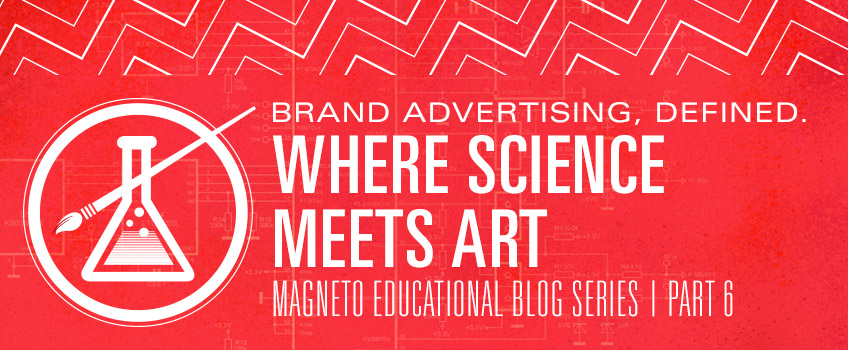In an increasingly metric-based industry, it’s important to remember that good creative work is at the heart of what we do.
Your creative—no matter the medium—needs to stand out and break through the clutter. Interesting, outlandish or humorous creative work that isn’t remembered or doesn’t motivate is essentially worthless.
That being said, brand advertising is just as much about science as it is about art. The tools we have at our disposal enable us to do our science more effectively today than has ever been possible in the past. Analytics, tracking, and a host of optimization tools—all of which tell us in real time whom we are reaching and how they are interacting with our messages.
Of course, algorithms can’t produce the kind of engaging creative that helps brand advertising campaigns stand out. That’s art’s job.
You see, art is predicated on hunches and intuition; it’s meant to evoke emotional responses. Science, on the other hand, is about systematic processes and rigorous evaluation. You can think of art as the experience, and science as the vehicle through which that experience is delivered.
And try as you may to tackle your advertising endeavors with only one or the other in mind, the truth is, you’re going to need them both.
Channeling Your Inner Artistic Scientist (Or Scientific Artist, Depending On How You See It)
If there’s one thing artists and scientists have in common, it’s that they are always observing their environments. Whether you consider yourself more of a right-brain thinker or a left-brain thinker, there’s plenty from which you can draw inspiration.
Be a student of the world—a sponge that is ready to absorb any and all ideas you like. What are the trends that caught your attention? What kind of music made you feel inspired? Film techniques, print layouts, snazzy logo designs—take note and keep a file.
Having a treasure trove of inspiration to draw from will go a long way toward generating a productive brainstorming session—which, by the way, is going to happen a lot during the beginning stages of your project. All ideas are not created equal, but almost anything goes while you’re brainstorming. Just make sure you’re going deep and moving past what’s easy or obvious.
These are the principles that should guide your creative development:
- Brevity: Keep it simple, keep it short and be engaging without saying too much.
- Authenticity: Your creative should be unique, arresting and compelling. Being real is better than relying on borrowed interest; and unless you can afford to constantly shift with changing trends, err on the side of originality rather than what’s hot at the moment.
- Stickiness: Make it memorable, make it relevant and be consistent in the brand’s messaging and tone. Also be sure to include a clear call to action, so that once your audience is effectively engaged, they’ll know where to go from there.
Setting Yourself Up For Success
The research and planning stage is where a lot of the science comes into play. That’s because, in order for your advertising to be successful, you have to know where and how to distribute it. Who is your target market? And how do they live? Efforts should be made to find out anything and everything about your target’s needs, desires, likes and dislikes. This will serve as your roadmap, and will inform your creative brief.
If you’re wondering what a creative brief is, or you know what it is and you’re wondering why we’re telling you to work from one, let’s jump right into CB 101: Introduction to Creative Briefs.
A creative brief is a concise but informative document that answers every important question you need to successfully complete your project. It’s the who, what, when, where and—perhaps most importantly—the why. What is this project? Who is it for? Why is it necessary? If you don’t have an answer to these questions, you are not ready to move forward with your plan.
While every creative brief is going to look different depending on what kind of product or service you are trying to advertise, the meat and potatoes will remain relatively unchanged.
Here’s a list of things your creative brief should include:
- Background: This is where you dive into the client’s history, the history of the product or service they are trying to sell, and other general research and information-gathering efforts.
- Overview: This section is about the product or service; the what, the why and the perceived opportunities.
- Objectives: Clearly defined goals make for a clearly defined plan of action.
- Audience: What are the attitudes and motivations of your target audience?
- Competitors: Who else is doing this? And what kind of lack can we fulfill?
- Deliverables: Effective communication about what the client expects from the agency is the key to building long-term relationships—and to making sure the project is up to snuff, of course.
Once you’ve filled in all these blanks, it should be pretty easy to throw in details about the intended tone of the messaging and the artistic direction of the visuals. Then you’ll be ready to rock and roll.
Stay tuned for our next installment of Brand Advertising, Defined, where we will dive deeper into the abyss that is the creative process.
Share:
Recent Posts
- 9/22/2016 • Magneto Creates M Financial’s 2015 Annual Report
- 8/03/2016 • Magneto aligns Marger Johnson’s look with the industries it serves
- 7/20/2016 • Magneto brings bold vision to City Color branding and website development
- 7/13/2016 • Brand Advertising, Defined: The Creative Process
- 5/25/2016 • Brand Advertising, Defined: Where Science Meets Art



